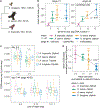Polyploidy in Xenopus lowers metabolic rate by decreasing total cell surface area
- PMID: 37080197
- PMCID: PMC10184464
- DOI: 10.1016/j.cub.2023.03.071
Polyploidy in Xenopus lowers metabolic rate by decreasing total cell surface area
Abstract
Although polyploidization is frequent in development, cancer, and evolution, impacts on animal metabolism are poorly understood. In Xenopus frogs, the number of genome copies (ploidy) varies across species and can be manipulated within a species. Here, we show that triploid tadpoles contain fewer, larger cells than diploids and consume oxygen at a lower rate. Drug treatments revealed that the major processes accounting for tadpole energy expenditure include cell proliferation, biosynthesis, and maintenance of plasma membrane potential. While inhibiting cell proliferation did not abolish the oxygen consumption difference between diploids and triploids, treatments that altered cellular biosynthesis or electrical potential did. Combining these results with a simple mathematical framework, we propose that the decrease in total cell surface area lowered production and activity of plasma membrane components including the Na+/K+ ATPase, reducing energy consumption in triploids. Comparison of Xenopus species that evolved through polyploidization revealed that metabolic differences emerged during development when cell size scaled with genome size. Thus, ploidy affects metabolism by altering the cell surface area to volume ratio in a multicellular organism.
Keywords: Kleiber’s law; Xenopus; cell size; energy budget; metabolism; oxygen consumption rate; polyploidy; scaling.
Copyright © 2023 The Authors. Published by Elsevier Inc. All rights reserved.
Conflict of interest statement
Declaration of interests The authors declare no competing interests.
Figures





Similar articles
-
Comparison of metabolic scaling between triploid and diploid common carp.J Comp Physiol B. 2021 Jul;191(4):711-719. doi: 10.1007/s00360-021-01365-x. Epub 2021 Apr 3. J Comp Physiol B. 2021. PMID: 33811547
-
Ploidy and hybridity effects on leaf size, cell size and related genes expression in triploids, diploids and their parents in Populus.Planta. 2019 Mar;249(3):635-646. doi: 10.1007/s00425-018-3029-0. Epub 2018 Oct 16. Planta. 2019. PMID: 30327883
-
Low Temperature and Polyploidy Result in Larger Cell and Body Size in an Ectothermic Vertebrate.Physiol Biochem Zool. 2016 Mar-Apr;89(2):118-29. doi: 10.1086/684974. Epub 2016 Jan 13. Physiol Biochem Zool. 2016. PMID: 27082722
-
Rise and persistence of animal polyploidy: evolutionary constraints and potential.Cytogenet Genome Res. 2013;140(2-4):151-70. doi: 10.1159/000353464. Epub 2013 Jul 5. Cytogenet Genome Res. 2013. PMID: 23838539 Review.
-
Development of polyspermic zygote and possible contribution of polyspermy to polyploid formation in angiosperms.J Plant Res. 2017 May;130(3):485-490. doi: 10.1007/s10265-017-0913-9. Epub 2017 Mar 8. J Plant Res. 2017. PMID: 28275885 Review.
Cited by
-
Polyploid Cancer Cell Models in Drosophila.Genes (Basel). 2024 Jan 14;15(1):96. doi: 10.3390/genes15010096. Genes (Basel). 2024. PMID: 38254985 Free PMC article. Review.
-
Integrating the Study of Polyploidy Across Organisms, Tissues, and Disease.Annu Rev Genet. 2024 Nov;58(1):297-318. doi: 10.1146/annurev-genet-111523-102124. Epub 2024 Nov 14. Annu Rev Genet. 2024. PMID: 39227132 Free PMC article. Review.
-
Eukaryotic cell size regulation and its implications for cellular function and dysfunction.Physiol Rev. 2024 Oct 1;104(4):1679-1717. doi: 10.1152/physrev.00046.2023. Epub 2024 Jun 20. Physiol Rev. 2024. PMID: 38900644 Free PMC article. Review.
-
Significance of quantitative analyses of the impact of heterogeneity in mitochondrial content and shape on cell differentiation.Open Biol. 2024 Jan;14(1):230279. doi: 10.1098/rsob.230279. Epub 2024 Jan 17. Open Biol. 2024. PMID: 38228170 Free PMC article. Review.
-
Pathway to Independence: the future of developmental biology.Development. 2023 Oct 1;150(19):dev202360. doi: 10.1242/dev.202360. Epub 2023 Oct 9. Development. 2023. PMID: 37812057 Free PMC article.
References
-
- Storchova Z, and Pellman D (2004). From polyploidy to aneuploidy, genome instability and cancer. Nat. Rev. Mol. Cell Biol 5, 45–54. - PubMed
-
- Soltis PS, Marchant DB, Van de Peer Y, and Soltis DE (2015). Polyploidy and genome evolution in plants. Curr. Opin. Genet. Dev 35, 119–125. - PubMed
-
- Small CD, Davis JP, Crawford BD, and Benfey TJ (2021). Early, nonlethal ploidy and genome size quantification using confocal microscopy in zebrafish embryos. J. Exp. Zool. Part B Mol. Dev. Evol 336, 496–510. - PubMed

